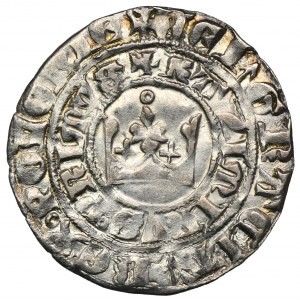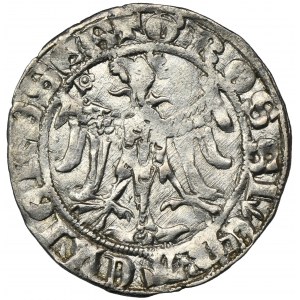SYMBOL of the Polish Middle Ages!
The first Polish penny, the Cracow penny of Casimir the Great, which was introduced around 1367, as a counterweight to the Prague pennies.
An extremely desirable and sought-after coin, an object of sighs of many collectors.
Excellent, glossy art on both sides. Very good detail and a healthy surface.
Centering, heavily minted, but with scarcity typical of these issues. Legible on both sides.
One of the prettiest pieces offered so far on the auction market in Poland.
A symbol of the Polish Middle Ages, an icon of Polish numismatics, a historical and beautiful coin, whose uniqueness will delight a new purchaser for life, whose future eventual resale, due to its uniqueness, will always be on the owner's terms! An object of sighs of lovers of Polish numismatics, a coin that gives prestige to any collection!
Obverse: modeled crown with a central fleuron ending in a ring
Inner hoop: +KΛZIMIRVS:PRIMVS , outer hoop: +DЄI↑GRΛCIΛ↓RЄX⸰POLONIЄ
Reverse: crowned Piast eagle
+GROSSI↓CRCVIЄNSЄS
Matching legends listed by Ryszard Kiersnowski: obverse legend type 17, reverse legend type G.
Diameter 27 mm, weight 3.15 g
Kazimierz Stronczynski in his work "Dawne Monety Polskie Dynastyi Piastów i Jagiellonów" writes about this issue as follows: "...This is a coin not only in this reign, but also in the whole range of Polish coins unique...".
During the reign of Casimir III the Great (1333-1370), three types of coarser money were minted, with which is connected the penny reform carried out at an unspecified time. The largest of the newly introduced denominations was the Cracow penny, whose name is not known from documents, but from the obverse's obverse legend - GROSSI CRACOVIENSES, which is an obvious imitation of the Prague penny legend - GROSSI PRAGENSES. On the obverse, the inner rim of the Polish penny reads KAZIMIRVS PRIMVS ('Casimir the First'), and the outer rim complements this legend - DEI GRATIA REX POLONIE ('By God's Grace, King of Poland'). In the obverse field we see a crown very similar to that of the Prague penny of Charles IV (1346-1378). The reverse reads GROSSI CARCOVIENSES, and the legend surrounds a crowned Piast eagle with its head facing left. Cracow's pennies differed in nuances in the obverse legends - primarily interword stamps and different variants of the writing of the royal name in the inner rim of the obverse and the ending of the legend from the outer rim of this side of the coin. Also the reverse legend was often minted with numerous errors. So far only Ryszard Kiersnowski has compiled all the inscription variants present on these coins, singling out 22 types of obverse legend and 13 types of reverse legend. One Polish fine was used to mint 60 Cracow pennies, which were supposed to weigh 3.270 g. However, from the metric data recorded by Ryszard Kiersnowski of 39 pieces of Cracow pennies, it appears that their weight was able to fall below 3 g, and the most recorded coins weighed 3,110-3,200 g.
In addition to the Cracow penny, Casimir the Great's reform also envisaged the introduction of two smaller denominations - the large quarto and the small quarto. Ryszard Kiersnowski postulated that the reorganization of Polish minting carried out by Casimir the Great took place in two stages. Large quarters, which are more often noted in finds, were introduced first, and only in the second stage were small quarters introduced, along with Cracow pennies. Kiersnowski dated the second stage of the reform to the end of Casimir's reign, i.e. the last months of 1370, which is how the rarity of both types of coins can be explained. Small quarters, on the other hand, according to Kiersnowski, were introduced into issue around 1365-1367, and according to the findings of Borys Paszkiewicz, in 1366 at the latest. According to the latest research, it is presumed that Cracow pennies were conducted in the second half of the 1460s - 1365-1370.
The monetary reform carried out by Casimir the Great introduced a multi-fractional system for the first time in Poland, which included denarii, small quarters (quarter pennies), large quarters (half pennies) and Cracow pennies.
Literature
Kiersnowski R.
2008a The date and shape of Kazimierz the Great's monetary reforms, [in:] Eadem, Historia-Pieniądz-Herb, Warsaw, pp. 195-234.
2008b Casimir the Great's pennies, [in:] Eadem, Historia-Pieniądz-Herb , Warsaw, pp. 235-267.
Paszkiewicz B.
2008 De moneta in Regno currente: The Polish Minting of Casimir the Great, "Roczniki Historyczne," R. LXXIV, pp. 31-54.









